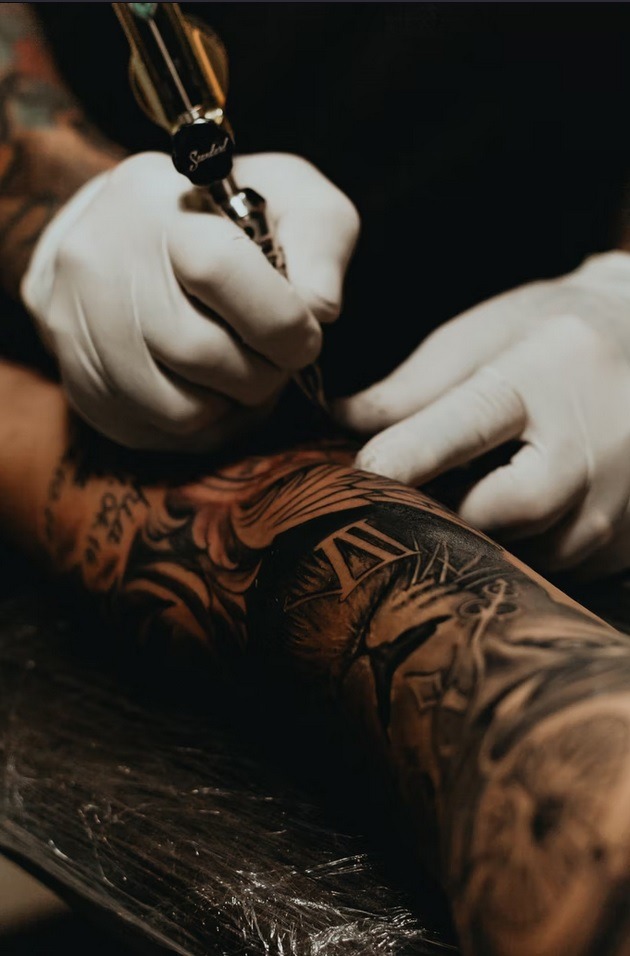A tattoo is a type of body modification in which indelible or temporary tattoo ink, dyes, and/or pigments are inserted into the dermis layer of the skin to create a design. Tattoo artists use a variety of tattooing processes and techniques to create these designs, including hand-tapped traditional tattoos and modern tattoo machines. Tattooing has a long history of how were tattoos invented, dating back to Neolithic times, and is practiced by many cultures around the world. The symbolism and impact of tattoos vary depending on the location and culture.
People today get tattoos for a variety of reasons, including artistic, cosmetic, sentimental, religious, and spiritual reasons, as well as to symbolize their belonging to or identification with specific groups, such as criminal gangs, ethnic groups, or law-abiding subcultures. Tattoos can express feelings toward a relative or an unrelated person. Also, be ready on how tattoos limit career.
How Tattoos Are Done?
A tattoo is a permanent mark or design on your skin created by pricking pigments into the top layer of the skin. The tattoo artist usually uses a hand-held machine that works similarly to a sewing machine, with one or more needles repeatedly piercing the skin. The needles inject tiny ink droplets into each puncture. The procedure, which is performed without anesthetics, results in minor bleeding and minor to moderate pain.
Tattoos Have Led To Errors in Medical Treatment
Magnetic resonance imaging studies may react with metal-based ink tattoos. Two case studies, for example, describe patients who had MRI-induced tattoo burns that were attributed to iron compounds in tattoo pigments. This magnet-based reaction is rare, according to radiologists, but some have suggested simply avoiding iron-based tattoo inks.
Meanwhile, pathologists have discovered tattoo ink in surgical lymph node biopsy specimens. For example, a case study published in the journal Obstetrics and Gynecology in 2015 described a young woman who had cervical cancer that had spread to her lymph nodes. They discovered that what appeared to be malignant cells in a scan was tattoo ink after surgery to remove the nodes. Another melanoma patient received a similar misdiagnosis.
Risks of Having A Tattoo
Because tattoos pierce the skin, infections and other complications, such as skin cancer, are possible:
1. Allergic Reactions
Tattoo dyes, particularly those that are red, green, yellow, or blue, can cause allergic skin reactions such as an itchy rash at the tattoo site. This can happen even years after the tattoo is applied. If you have sensitive skin to certain perfumes, cosmetics, or lotions, you should think twice about getting a tattoo. Individuals who are allergic to the dyes used in tattoos are fairly common. Tattoos are sometimes mistakenly thought to contain harmless paint or ink. However, this ink contains numerous chemicals and unnatural ingredients that can cause skin irritation. If you have sensitive skin or experience frequent allergic reactions, you should speak with an allergist before getting a tattoo.
2. Cancer
Health officials and researchers have also expressed concern about blackout tattoos. This hot new trend could be particularly hazardous because it requires people to cover large areas of their bodies in thick, heavy solid black ink. Individuals are concerned not only about the carcinogens in the ink but also about the way these tattoos cover the body. One of the first signs of skin cancer, particularly melanoma, is a change in skin pigmentation. Individuals who have their bodies blacked out with tattoo ink may not notice these changes right away. As a result, tattoos should never be applied over moles, birthmarks, or other skin discolorations or abnormalities that already exist.
Black ink is especially dangerous when it comes to cancer because it contains a high level of benzo(a)pyrene. The International Agency for Research on Cancer has classified benzo(a)pyrene as a carcinogen. Because black tattoo ink is the most commonly used color for tattooing, health officials and researchers are particularly concerned about its effects.
3. Hepatitis
When it comes to getting a tattoo, hepatitis is a major concern. Hepatitis is almost exclusively spread between people who share needles. This is why you must thoroughly research your tattoo parlor before allowing them to tattoo you. Before tattooing each customer, inspect their shop several times to ensure that all employees are wearing gloves and using new, clean needles. Run away if you see someone using the same needle for multiple tattoos or people.
4. MRI Complications
During Magnetic Resonance Imaging (MRI) exams, tattoos or permanent makeup may cause swelling or burning in the affected areas. In some instances, tattoo pigments can degrade the image quality.
5. Other Skin Problems
A granuloma is a type of inflammation that can form around tattoo ink. Tattooing can also cause keloids, which are raised areas caused by scar tissue overgrowth.
Insist on Safety Precautions if Getting A Tattoo
Ask these questions to ensure that your tattoo is applied safely:
1. Who Does The Tattooing?
Visit a reputable tattoo parlor with only properly trained employees. Keep in mind that regulations and licensing requirements differ from state to state. For information on local licensing and regulations, contact your city, county, or state health department.
2. Does the Tattoo Artist Wear Gloves?
For each procedure, make sure the tattoo artist cleans his or her hands and puts on a new pair of protective gloves.
3. Does the Tattoo Artist Use Proper Equipment?
Before your procedure begins, make sure the tattoo artist removes the needle and tubes from the sealed packages. Any pigments, trays, or containers that have not been used should also be discarded.
4. Does the Tattoo Artist Sterilize Non-disposable Equipment?
Make sure the tattoo artist sterilizes all non-disposable equipment between customers with a heat sterilization machine. After each use, disinfect instruments and supplies that can’t be sterilized with an autoclave, such as drawer handles, tables, and sinks, with a commercial disinfectant or bleach solution.
Take Good Care Of Your Tattoo
1. Keep the Tattooed Skin Clean
Use a gentle touch and plain soap and water. Prevent direct streams of water on the newly tattooed skin while showering. Pat the area dry, not rub it.
2. Use Moisturizer
Apply a light moisturizer to the tattooed skin daily.
3. Avoid Sun Exposure
For at least a few weeks, keep the tattooed area out of the sun.
4. Avoid Swimming
While your tattoo is healing, stay away from pools, hot tubs, rivers, lakes, and other bodies of water.
5. Choose Clothing Carefully
Wear nothing that could get stuck in the tattoo.
6. Allow Up To 2 Weeks of Healing
Picking at scabs increases the risk of infection while also damaging the design and causing scarring.


